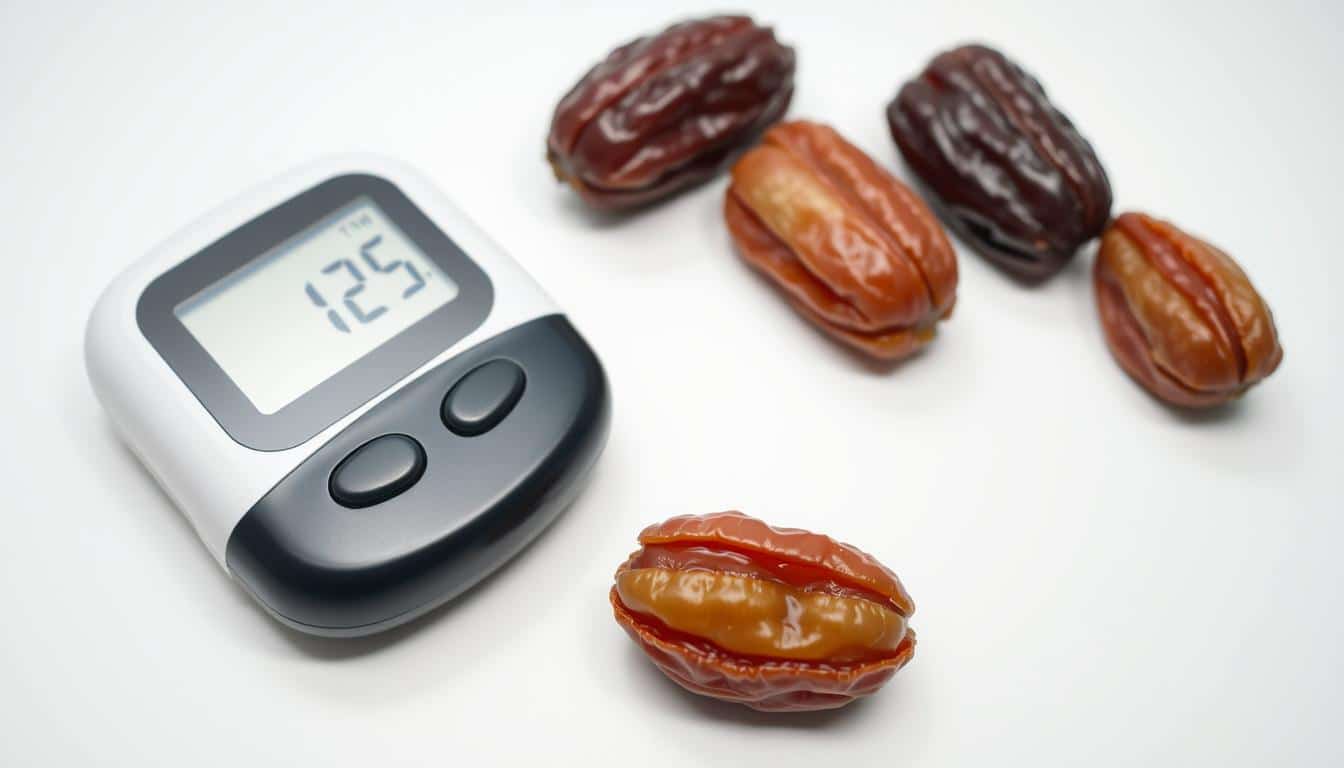Navigating sweet foods while managing blood glucose can feel challenging. This guide explores how natural sugars in ancient fruits like dates interact with your body. With a 6,000-year history of cultivation, dates remain a nutrient-dense choice packed with fiber, potassium, and antioxidants.
A single Medjool date contains roughly 66.5 calories and 16 grams of natural sugar. However, its 1.6 grams of fiber per serving helps slow sugar absorption. Research suggests that moderate portions—2-3 dates daily—may fit into balanced meal plans without spiking blood sugar levels dramatically.
Medical experts emphasize pairing this fruit with protein or healthy fats to further stabilize glucose response. For example, adding almonds or Greek yogurt creates a satisfying snack. Portion control remains critical, as overconsumption could raise carbohydrate intake beyond individual needs.
This article breaks down the science behind dates’ effects on diabetes management, supported by clinical studies. You’ll learn practical strategies to enjoy their natural sweetness while prioritizing your long-term health.
Overview of Dates: History, Nutrition, and Relevance for Your Health
For millennia, civilizations have prized dates not just as sustenance but as symbols of vitality. These fruits grew alongside early human settlements in Mesopotamia, becoming staples in Middle Eastern diets and spiritual practices.
Historical and Cultural Significance
Ancient traders carried dates along the Silk Road, spreading their use from North Africa to Asia. They appear in religious texts and traditional medicine, often symbolizing prosperity. Today, they remain central to cultural celebrations like Ramadan and holiday feasts.
Nutritional Breakdown and Key Vitamins
A single serving delivers 15% of your daily potassium needs and 12% of magnesium requirements. Dates provide B vitamins for energy metabolism and selenium for immune support. Their antioxidant content—including flavonoids and carotenoids—helps combat oxidative stress.
With 7 grams of fiber per 3.5-ounce serving, dates promote digestive health while slowing glucose absorption. Though high in natural sugars, their low glycemic index (42-55) makes them a smarter carbohydrate choice than refined sweets. Pairing them with protein sources like nuts enhances satiety and blood sugar stability.
Are dates good for diabetics: Effects on Blood Sugar
Maintaining steady glucose levels requires understanding how different foods interact with your system. Blood sugar measures how much sugar circulates in your bloodstream after eating. For those managing diabetes, keeping these levels stable prevents energy crashes and long-term complications.
From Plate to Bloodstream: The Digestion Process
When you consume this fruit, its natural sugars don’t flood your system immediately. The 1.6 grams of fiber per date acts like a slow-release mechanism. This delays carbohydrate breakdown, preventing sudden surges in blood sugar.
What Research Reveals About Glycemic Impact
Studies show dates have a glycemic index of 42—lower than white bread (75) or rice (73). In one trial, participants eating 2-3 servings daily saw no significant spikes in glucose levels. Their insulin response remained steadier compared to refined sugar consumption.
Pairing this snack with proteins like walnuts enhances its benefits. The combination slows digestion further, helping your body manage sugar absorption. Always account for their carbohydrate content in your daily meal plan to maintain balance.
While individual tolerance varies, evidence supports that moderation makes this ancient fruit a viable option. Consult your healthcare provider to determine personalized portion limits aligned with your health goals.
Nutrient Benefits of Dates for Managing Diabetes
Understanding the nutritional powerhouse of this ancient fruit reveals why it’s valued in diabetes management. Beyond natural sweetness, dates deliver a concentrated mix of fiber and essential minerals that support metabolic health.
Fiber’s Role in Regulating Blood Sugar
Each Medjool date contains 1.6 grams of dietary fiber—about 6% of your daily needs. This soluble fiber forms a gel-like substance in your gut, slowing carbohydrate breakdown. By delaying sugar absorption, it helps prevent rapid blood sugar spikes after meals.
Research shows high-fiber diets improve glucose control in those with insulin resistance. A 2021 study found consuming 30 grams of daily fiber reduced type 2 diabetes risk by 24%. Pairing this fruit with protein sources amplifies these stabilizing effects.
Essential Minerals: Magnesium, Potassium, and More
Two pitted dates provide 26 mg of magnesium—7% of your daily requirement. This mineral enhances insulin sensitivity by activating enzymes that process carbohydrates. Low magnesium levels correlate with poorer blood sugar regulation in clinical trials.
Potassium in dates supports nerve function and counters sodium’s effects on blood pressure. With 167 mg per serving, it aids muscle contractions and fluid balance—critical for those managing metabolic conditions. Antioxidants like flavonoids further protect cells from oxidative damage linked to chronic diseases.
These nutrients work synergistically, making controlled portions a strategic addition to balanced meal plans. Always consult your healthcare team to align intake with personal health targets.
Glycemic Index and Dietary Impact of Dates
Understanding how foods affect blood sugar levels requires two key metrics: glycemic index (GI) and glycemic load (GL). While GI measures how quickly carbohydrates raise glucose, GL accounts for portion size. Both tools help you make informed choices about carbohydrate-rich foods.

Balancing Metrics for Better Choices
Dates have a low glycemic index of 42, much lower than white bread (75) or rice (73). This means their natural sugars enter your bloodstream gradually. However, their GL depends on how much you eat. Two pitted dates contain about 18 grams of carbs—equivalent to a moderate GL that won’t overwhelm your system.
Research shows consuming 2-3 dates with almonds creates a balanced snack. The fiber and protein in nuts slow digestion further, preventing rapid sugar spikes. Compare this to eating dates alone—though still better than refined sweets, pairing enhances stability.
Portion control remains critical. A study in the Nutrition Journal found participants who ate 7-10 dates daily experienced higher glucose fluctuations. Stick to 1-2 servings (2-4 dates) spread throughout the day. Track your body’s response using a glucose monitor if possible.
By focusing on both GI and GL, you can enjoy this nutrient-rich fruit without compromising blood sugar management. Work with your dietitian to adjust portions based on your unique needs and health goals.
Incorporating Dates in Your Diabetic Meal Plan
Building a diabetes-friendly diet doesn’t mean eliminating sweetness entirely. With careful planning, you can enjoy nutrient-rich foods while maintaining stable blood sugar levels.
Mastering Quantity Matters
Stick to 2-3 pieces per serving—about the size of a golf ball. This provides natural sweetness without overwhelming your system with sugars. Research shows this portion contains 30-45 grams of carbs, fitting within most daily carbohydrate budgets.
Why does this matter? Smaller servings help prevent rapid glucose spikes while delivering essential nutrients. Track your body’s response using a meter if possible, adjusting portions based on individual tolerance.
Synergistic Food Combinations
Pair this fruit with protein-rich allies like almond butter or cottage cheese. The fat and protein in these foods slow digestion, creating a gradual sugar release into your bloodstream.
Try stuffing pitted varieties with walnuts for a satisfying snack. Blend them into Greek yogurt parfaits or oatmeal for breakfast. These combinations enhance satiety and provide sustained energy—key for managing diabetes effectively.
By focusing on balance rather than restriction, you create meals that support both health goals and taste preferences. Always discuss dietary changes with your healthcare provider to ensure alignment with your treatment plan.
Health Risks and Considerations When Eating Dates
Balancing nutritional benefits with potential risks ensures you maximize this fruit’s value without compromising wellness. While nutrient-dense, its concentrated natural sugars demand mindful consumption—especially for those monitoring metabolic health.

Caloric and Sugar Content Concerns
A single Medjool date packs 16 grams of natural sugar—equivalent to 4 teaspoons. Eating 7-10 daily adds 112-160 grams of carbohydrates, potentially exceeding recommended daily intake limits. Studies show this quantity may elevate blood sugar levels by 30-45 mg/dL in individuals with insulin resistance.
Research in the Journal of Nutritional Science found consuming 4 dates at once caused sharper glucose spikes than smaller portions. Larger varieties like Medjool require extra caution due to their higher calorie density (66 calories per piece).
Potential Side Effects of Overconsumption
Exceeding 3-4 daily servings may trigger digestive discomfort from excess fiber. Bloating or diarrhea can occur if your system isn’t accustomed to high-fiber foods. Weight management also becomes challenging, as 10 dates contain nearly 500 calories—25% of some adults’ daily needs.
For those managing diabetes, uncontrolled portions might disrupt medication effectiveness. A 2015 trial revealed participants eating 90 grams daily (about 7 dates) experienced 18% higher post-meal sugar levels compared to those limiting intake to 30 grams.
Work with your healthcare team to establish safe thresholds. Pairing with protein sources like almonds helps mitigate risks while preserving enjoyment. Remember: moderation transforms potential hazards into manageable choices.
Tips for Safely Enjoying Dates in Your Diet
Balancing flavor and health goals starts with smart strategies. Medical News Today and the American Diabetes Association recommend pairing this fruit with nutrient-dense foods to minimize blood sugar fluctuations. Let’s explore practical ways to integrate its natural sweetness without compromising wellness.
Practical Recommendations for Daily Intake
Limit portions to 2-3 pieces daily—roughly the size of a closed fist. Chop them into oatmeal or mix with unsweetened Greek yogurt for balanced meals. Their fiber content works best when combined with proteins like almond butter, which slows sugar absorption.
Try blending one pitted date into smoothies or sprinkling slices over salads. Always measure servings to avoid accidental overconsumption. Track blood sugar levels before and after eating to identify personal tolerance thresholds.
Consulting Your Healthcare Provider
Discuss dietary changes with your care team to align with medication and health targets. Those using insulin pumps or glucose monitors may need adjusted carb counts. Research shows individualized plans reduce risk factors more effectively than generic guidelines.
Remember: moderation and mindful pairing let you enjoy nutrient-rich foods sustainably. Prioritize whole-food combinations over processed snacks to maximize benefits like potassium intake and antioxidant support.
Conclusion
Managing blood sugar doesn’t require eliminating natural sweetness entirely. Research from Medical News Today confirms that this nutrient-rich fruit, when consumed mindfully, can complement a diabetes-friendly lifestyle. Its low glycemic index (42) and high fiber content help moderate glucose absorption, making controlled portions a viable option.
Packed with potassium, magnesium, and antioxidants, these fruits offer more than just energy—they support metabolic health. Pairing them with proteins like almonds or Greek yogurt enhances their stabilizing effect on blood sugar levels. Studies show 2-3 daily servings typically fit within most carbohydrate budgets.
However, balance remains essential. Overconsumption may increase sugar intake beyond individual needs, potentially affecting glucose management. Always consult your healthcare provider to align dietary choices with medications and personal targets.
By prioritizing portion control and strategic food combinations, you can enjoy their rich flavor while maintaining wellness. Informed decisions transform this ancient superfood into a smart addition to balanced meal plans for people with diabetes.
FAQ
Can people with diabetes safely consume dates?
Yes, in moderation. Dates contain natural sugars but also provide fiber, magnesium, and potassium, which support blood sugar management. Pairing them with protein or healthy fats like almonds can minimize glucose spikes.
What is the glycemic index of dates?
Dates have a medium glycemic index (GI) of around 42–55, depending on the variety. Their glycemic load (GL) is moderate, meaning they have a slower impact on blood sugar when eaten in small portions.
How does fiber in dates affect blood sugar levels?
The 7 grams of fiber per 3.5-ounce serving slows carbohydrate digestion, reducing rapid glucose spikes. This helps maintain steadier blood sugar levels, making dates a better option than refined sugars for those managing diabetes.
What serving size of dates is recommended for diabetics?
Stick to 1–2 dates (about 20–30 grams) per serving. Combine them with unsweetened Greek yogurt or nut butter to balance their natural sweetness and enhance nutrient absorption.
Are there risks to eating dates if you have insulin resistance?
Overconsumption may lead to elevated blood sugar due to their carbohydrate content. Monitor your body’s response and consult a dietitian to adjust intake based on your individual glucose tolerance and health goals.
Which nutrients in dates support metabolic health?
Magnesium improves insulin sensitivity, potassium aids heart health, and antioxidants combat inflammation. These nutrients collectively help reduce diabetes-related complications when part of a balanced diet.
Should you check blood sugar after eating dates?
Yes. Use a glucometer to track how your body reacts. This helps determine personalized portion limits and ensures dates fit safely into your meal plan without unwanted spikes.
Can dates replace artificial sweeteners in diabetic-friendly recipes?
Absolutely. Blend dates into energy balls or oatmeal for natural sweetness. Their low to medium GI and high nutrient density make them a healthier alternative to processed sugars in moderation.


